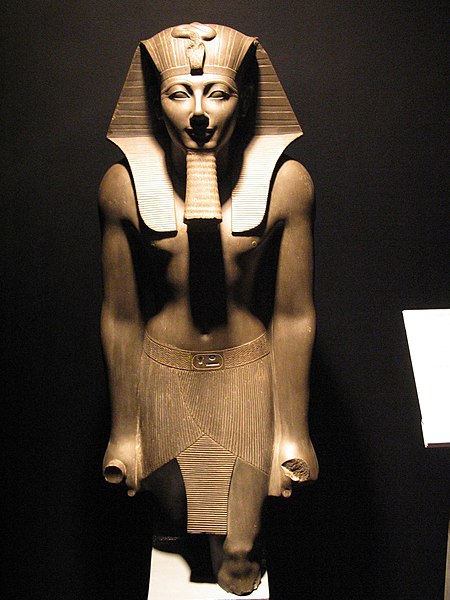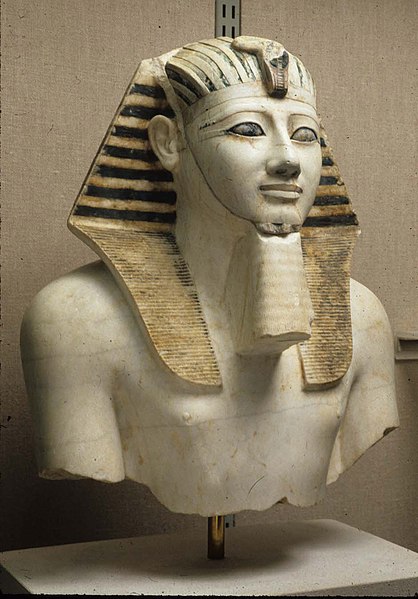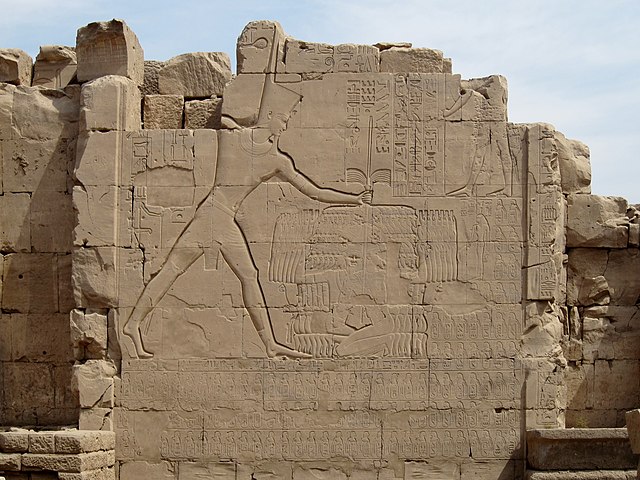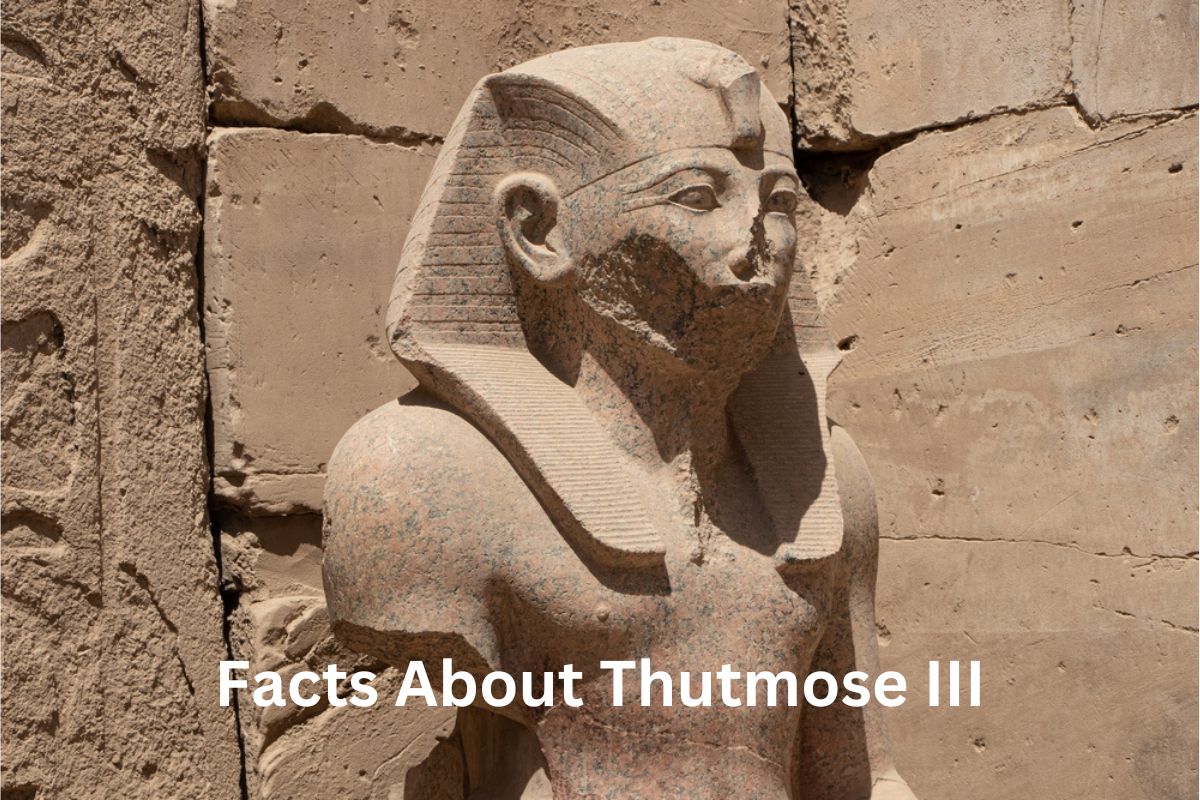Thutmose III, also known as Thutmose the Great, was an ancient Egyptian pharaoh who reigned during the New Kingdom period from approximately 1479 to 1425 BCE. He was the sixth pharaoh of the 18th Dynasty and a member of the Thutmosid dynasty.
Thutmose III is widely regarded as one of Egypt’s greatest warrior kings, known for his military prowess and strategic brilliance. His reign was marked by extensive military campaigns and conquests that expanded the Egyptian empire to its greatest extent.
Alongside his military achievements, Thutmose III also made significant contributions to architecture, religion, and the arts, leaving a lasting legacy in ancient Egyptian history.
Thutmose III Facts
1. Thutmose III, also known as Thutmose the Great, ruled from approximately 1479 to 1425 BCE
Thutmose III, also known as Thutmose the Great, was an ancient Egyptian pharaoh who reigned from approximately 1479 to 1425 BCE during the New Kingdom period.
The New Kingdom was a time of great political and cultural development in ancient Egypt, characterized by military expansion, wealth, and architectural achievements.

2. He was the sixth pharaoh of the 18th Dynasty of Egypt and was a member of the Thutmosid dynasty
He was the sixth pharaoh of the 18th Dynasty of Egypt and was a member of the Thutmosid dynasty. The Thutmosid dynasty was a prominent royal lineage that ruled Egypt for several generations.
Also Read: Thutmose III Accomplishments
Thutmose III inherited the throne from his father, Thutmose II, and continued the dynasty’s legacy of power and conquest.
3. Thutmose III was the son of Thutmose II and a minor wife named Iset
Thutmose III was the son of Thutmose II and a minor wife named Iset. His father’s main wife, Hatshepsut, played a significant role in his early life. After Thutmose II’s death, Hatshepsut became regent for Thutmose III, as he was still a young child.
However, Hatshepsut eventually declared herself pharaoh and ruled as such for several years before Thutmose III took full control of the throne. The co-regency and subsequent transition of power between Hatshepsut and Thutmose III were critical moments in Egyptian history.

4. After the death of his father and the end of Hatshepsut’s regency, Thutmose III ascended to the throne at a young age
After the death of his father and the end of Hatshepsut’s regency, Thutmose III ascended to the throne at a young age, around 2 years old. Initially, his stepmother, Hatshepsut, acted as his regent.
However, as Thutmose III grew older, tensions arose between him and Hatshepsut, leading to a power struggle. Eventually, Thutmose III asserted his authority and took full control of the kingdom, sidelining Hatshepsut’s influence.
5. Thutmose III is best known for his military campaigns and conquests
Thutmose III is best known for his military campaigns and conquests. He led numerous successful military expeditions into Canaan, Syria, Nubia, and other neighboring regions.
His military campaigns aimed to expand Egypt’s territory, secure important trade routes, and exert control over vassal states. Thutmose III’s conquests were remarkable not only for their scale but also for their strategic planning and execution.
6. One of his most famous military victories was the Battle of Megiddo in 1457 BCE
One of his most famous military victories was the Battle of Megiddo in 1457 BCE. Megiddo was a strategically important city in Canaan, and its conquest was crucial for Egyptian control over the region.

Thutmose III employed a tactical surprise attack, utilizing a hidden path to flank the enemy forces. The battle resulted in a decisive Egyptian victory, and Thutmose III’s tactics became a model for future military campaigns.
The Battle of Megiddo solidified Egypt’s dominance in the region and allowed Thutmose III to establish Egyptian rule over Canaan and its surrounding territories.
7. Thutmose III implemented innovative military strategies, including the use of chariots and infantry formations
Thutmose III implemented innovative military strategies, including the use of chariots and infantry formations. He reorganized the Egyptian army, dividing it into specialized units, such as archers, spearmen, and chariotry.
This reorganization allowed for more efficient and coordinated military operations. Thutmose III’s military reforms significantly enhanced the Egyptian army’s effectiveness and contributed to his success on the battlefield.
8. During his reign, Thutmose III commissioned several building projects, including temples, palaces, and monuments
During his reign, Thutmose III commissioned several building projects, including temples, palaces, and monuments. He sought to emphasize his power and divine status through these grand constructions.

Notable among these projects is the Temple of Amun at Karnak, which Thutmose III expanded and beautified. He also restored older structures, such as the Temple of Hatshepsut at Deir el-Bahari, ensuring their preservation and paying homage to his predecessors.
9. Thutmose III was a patron of the arts and encouraged the production of statues, reliefs, and other artistic works
Thutmose III was a patron of the arts and encouraged the production of statues, reliefs, and other artistic works. Many surviving artistic representations from his reign depict him in a victorious and heroic manner, showcasing his military achievements.
These artworks provide valuable insights into the artistic style and cultural norms of ancient Egypt during the New Kingdom period.
10. Thutmose III’s rule saw significant developments in trade and commerce, with the Egyptian empire becoming a dominant force in international trade
Thutmose III’s rule saw significant developments in trade and commerce. As the Egyptian empire expanded under his military campaigns, trade routes were secured, allowing for the flourishing of international trade.
Egyptian goods, especially luxury items such as gold, ivory, spices, and precious stones, were highly sought after by neighboring regions. The wealth accumulated through trade further fueled the prosperity of Egypt during Thutmose III’s reign and allowed for the funding of monumental construction projects.
The economic growth and international trade networks established during his rule played a crucial role in Egypt’s dominance and influence in the ancient Near East.
11. He promoted the worship of the traditional Egyptian gods and undertook religious rituals and festivals
Thutmose III promoted the worship of the traditional Egyptian gods and undertook religious rituals and festivals. He was a devout follower of the Egyptian pantheon and actively participated in religious ceremonies.
Thutmose III constructed or renovated several temples dedicated to various deities, including Amun, Ra, and Hathor. These religious endeavors aimed to maintain the favor of the gods and ensure the prosperity and stability of Egypt under his rule.
12. Despite his military prowess, Thutmose III is believed to have been an educated and cultured ruler
Despite his military prowess, Thutmose III is believed to have been an educated and cultured ruler. He valued education and promoted the arts and sciences. Thutmose III surrounded himself with scholars and scribes, fostering an intellectual environment at his court.
The pharaoh himself was known to be well-read and knowledgeable about various subjects, including history, literature, and astronomy. His patronage of the arts and sciences contributed to the intellectual and cultural flourishing of Egypt during his reign.
13. Thutmose III had a long and prosperous reign, lasting for over 50 years
Thutmose III had a long and prosperous reign, lasting for over 50 years. His reign was characterized by stability, expansion, and the consolidation of Egyptian power.
Thutmose III’s ability to maintain control and manage the empire for such an extended period is a testament to his skill as a ruler and his ability to inspire loyalty among his subjects and officials.
14. Following his death, Thutmose III was buried in the Valley of the Kings, in a tomb known as KV34
Following his death, Thutmose III was buried in the Valley of the Kings, in a tomb known as KV34. The Valley of the Kings served as the final resting place for many pharaohs and members of the Egyptian elite during the New Kingdom.
Thutmose III’s tomb, though not as grand as some of the later royal burials, still contained treasures and funerary items befitting a pharaoh.
His mummy was discovered in 1881 by Émile Brugsch, and today it is housed in the Egyptian Museum in Cairo, where it provides valuable insights into the physical characteristics and burial practices of this renowned pharaoh.
15. Thutmose III’s reign is considered a golden age in ancient Egyptian history
Toward the end of his rule, Thutmose III appointed his son Amenhotep II as co-regent. This move ensured a smooth transition of power and allowed for a period of stability and continuity in the Egyptian monarchy.
Co-regencies were not uncommon in ancient Egypt and were often used to ensure a seamless transfer of power from one generation to the next. Thutmose III’s careful planning and foresight in designating Amenhotep II as his successor ensured the ongoing prosperity of Egypt.
